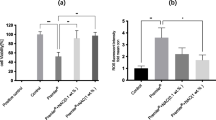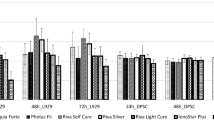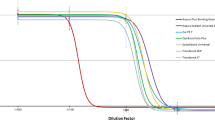Abstract
In order to test the hypothesis that released dental restorative materials can reach toxic levels in human oral tissues, the cytotoxicities of the resin-based dental (co)monomers hydroxyethylmethacrylate (HEMA), triethyleneglycoldimethacrylate (TEGDMA), urethanedimethacrylate (UDMA), and bisglycidylmethacrylate (BisGMA) compared with methyl mercury chloride (MeHgCl) and the amalgam component mercuric chloride (HgCl2) were investigated on human gingival fibroblasts (HGF) using two different test systems: (1) the modified XTT-test and (2) the modified H 33342 staining assay. The HGF were exposed to various concentrations of the test-substances in all test systems for 24 h. All tested (co)monomers and mercury compounds significantly (P<0.05) decreased the formazan formation in the XTT-test. EC50 values in the XTT assay were obtained as half-maximum-effect concentrations from fitted curves. Following EC50 values were found (mean [mmol/l]; s.e.m. in parentheses; n=12; * significantly different to HEMA): HEMA 11.530 (0.600); TEGDMA* 3.460 (0.200); UDMA* 0.106 (0.005); BisGMA* 0.087 (0.001); HgCl2* 0.013 (0.001); MeHgCl* 0.005 (0.001). Following relative toxicities were found: HEMA 1; TEGDMA 3; UDMA 109; BisGMA 133; HgCl2 887; MeHgCl 2306. A significant (P<0.05) increase of the toxicity of (co)monomers and mercurials was found in the XTT-test in the following order: HEMA < TEGDMA < UDMA < BisGMA < HgCl2 < MeHgCl. TEGDMA and MeHgCl induced mainly apoptotic cell death. HEMA, UDMA, BisGMA, and HgCl2 induced mainly necrotic cell death. The results of this study indicate that resin composite components have a lower toxicity than mercury from amalgam in HGF. HEMA, BisGMA, UDMA, and HgCl2 induced mainly necrosis, but it is rather unlikely that eluted substances (solely) can reach concentrations, which might induce necrotic cell death in the human physiological situation, indicating that other (additional) factors may be involved in the induction of tissue (pulp) inflammation effects after dental restauration.


Similar content being viewed by others
References
Abend M, Kehe K, Riedel M, Van Beuningen D (2000) Correlation of micronucleus and apoptosis assays with reproductive cell death can be improved by considering other modes of death. Int J Radiat Biol 76:249–259
Ashkenazi A, Dixit VM (1998) Death signaling and modulation. Science 281:1305–1308
Bean TA, Zhuang WC, Tong PY, Eick JD, Chappelow CC, Yourtee DM (1995) Comparison of tetrazolium colorimetric and 51Cr release assay for cytotoxicxity determination of dental biomaterials. Dent Mater 11:327–331
Belletti S, Orlandini G, Vettori MV, Mutti A, Uggeri J, Scandroglio R, Alinovi R, Gatti R (2002) Time course assessement of methylmercury effects on C6 glioma cells: Submicromolar concentrations induce oxidative DNA damage and apoptosis. J Neurosci Res 70:703–711
Boot JH (1996) Hepatotoxic effects of SH-reagents in human and rat hepatocyte cultures and in situ perfused rat livers. Cell Struct Funct 21:221–229
Bouillaguet S, Virgillito M, Wataha J, Ciucchi B, Holz J (1998) The influence of dentine permeability on cytotoxicity of four dentine bonding systems, in vitro. J Oral Rehabil 25:45–51
Denny MF, Atchison WD (1996) Mercurial-induced alterations in neuronal divalent cation homeostasis. Neurotoxicology 17:47–61
Engelmann J, Leyhausen G, Leibfritz D, Geurtsen W (2001) Metabolic effects of dental resin components in vitro detected by NMR spectroscopy. J Dent Res 80:869–875
Engelmann J, Leyhausen G, Leibfritz D, Geurtsen W (2002) Effect of TEGDMA on the intracellular Glutathione Concentration of Human Gingival Fibroblasts. J Biomed Mat Res 63:746–751
Ferracane JL, Condon JR (1990) Rate of elution of leachable components from composite. Dent Mater 6:282–287
Ferracane JL (1994) Elution of leachable components from composites. J Oral Rehabil 21:441–442
Forst HAT (1985) Probleme des multiplen Testens und Schätzens in der Arzneimittelforschung. Arzneim Forsch/Drug Res 35:3
Freidig A, Hofhuis M, van Holstijn I, Hermens J (2001) Glutathione depletion in rat hepatocytes: a mixture toxicity study with alpha,beta-unsaturated esters. Xenobiotica 31:295–307
Fujisawa S, Kadoma Y, Masuhara E (1984) A colorimetric study of the interaction of synthetic phospholipids liposomes with vinyl monomers, acrylates and methacrylates. J Biomed Mater Res 18:1105–1114
Gerzina T, Hume WR (1994) Effect of dentin on release of tegdma from resin composite in vitro. J Oral Rehabil 21:463–468
Gerzina T, Hume WR (1996) Diffusion of monomers from bonding resin resin composite combinations through dentine in vitro. J Dent 24:125–128
Geurtsen W, Schoeler U (1997) A 4-year retrospective clinical study of Class I and Class II composite restorations. J Dent Res 25:229–232
Geurtsen W (1998) Substances released from dental resin composites and glass ionomer cements. Eur J Oral Sci 106:687–695
Geurtsen W, Lehman F, Spahl W, Leyhausen G (1998) Cytotoxicity of 35 dental resin composite monomers/additives in permanent 3T3- and three human primary fibroblast cultures. J Biomed Mat Res 41:474–480
Halbach S (1994) Amalgamfüllungen: Belastung oder Vergiftung mit Quecksilber?. Dtsch Ärzteblatt 91:502–506
Hamid A, Okamoto A, Iwaku M, Hume WR (1998) Component release from light-activated glass ionomer and compomer cements. J Oral Rehabil 25:94–99
Hanks CC, Wataha JC, Parsell RR, Strawn SE (1992) Delineation of cytotoxic concentrations of two dentin bonding agents in vitro. J Endod 18:589–596
Heil J, Reifferscheild G, Waldmann P (1996) Genotoxicity of dental materials. Mutation Res 368:181–194
Issa Y, Watts DC, Brunton PA, Waters CM, Duxbury AJ (2004) Resin composite monomers alter MTT and LDH activity of human gingival fibroblasts in vitro. Dent Mater 20:12–20
Janke V, von Neuhoff N, Schlegelberger B, Leyhausen G, Geurtsen W (2003) Tegdma causes apoptosis in primary human gingival fibroblasts. J Dent Res 82:814–818
Kaga M (2001) The in vitro cytotoxicity of eluates from dentin bonding resins and their effect on tyrosine phosphorilation of L929 cells. Dent Mater 17:333–339
Kehe K, Reichl FX, Durner J, Walther U, Hickel R, Forth W (2001) Cytotoxicity of dental composite components and mercury compounds in pulmonary cells. Biomaterials 22:317–322
Landbeck P, Paulsen O (1995) Cytotoxic effects of four antibiotics on endothelial cells. Pharmacol Toxicol 77:365–370
Lee SY, Huang HM, Lin CY, Shih YH (1998) Leached components from dental composites in oral simulating fluids and the resultant composite strengths. J Oral Rehabil 25:575–578
Leite CM, Botelho AS, Oliveira JR, Cardoso SV, Loyola AM, Gomez RS, Vaz RR (2004) Immunolocalization of HLA-DR and metallothionein on amalgam tattoos. Braz Dent J 15:99–103
Lipfert FW, Moskowitz PD, Fthenakis V, Saroff L (1996) Probabilistic assessment of health risks of methylmercury from burning coal. Neurotoxicology 17:197–211
Liu XS, Li P, Widlak P, Zou H, Luo X, Gerrard W, Wang XD (1998) The 40-kDa subunit of DNA fragmentation factor induces DNA fragmentation and chromatin condensation during apoptosis. Proc Natl Acad Sci USA 95:8461–8466
Mac Lellan WR, Schneider MD (1997) Death by design. Circ Res 81:137–144
Mahaffey KR, Clickner RP, Bodurow CC (2004) Blood organic mercury and dietary mercury intake: National Health and Nutrition Examination Survey, 1999 and 2000. Environ Health Perspect 112:562–570
Malich G, Markovich B, Winder C (1998) Human cell line toxicity of binary and ternary chemical mixtures in comparison to individual toxic effects of their components. Arch Environ Contam Toxicol 35:370–376
Majno G, Joris I (1995) Apoptosis, oncosis, and necrosis-an overview of cell death. Am J Pathol 146:3–15
Martin MD, Williams BJ, Charleston JD, Oda D (1997) Spontaneous exfoliation of teeth following severe elemental mercury poisoning: case report and histological investigation for mechanism. Oral Surg Oral Med Oral Pathol Oral Radiol Endod 84:495–501
Mazzaoui SA, Burrow MF, Tyas MJ (2002) Long-term quantification of the release of monomers from dental resin composites and a resin-modified glass ionomer cement. J Biomed Mater Res 63:299–305
Ott KHR (1984) Zur Quecksilberbelastung durch Amalgamfüllungen. Dtsch Zahnärztl Z 39:199–205
Raffray M, Cohen GM (1997) Apoptosis and necrosis in toxicology: a continuum or distinct modes of cell death?. Pharmacol Ther 75:153–177
Ratanasathien S, Wataha JC, Hanks CT, Dennison JB (1995) Cytotoxic interactive effects of dentin bonding components on mouse fibroblasts. J Dent Res 74:1602–1606
Rathburn MA, Craig RG, Hanks CT, Filisko FE (1991) Cytotoxicity of a Bis-GMA dental composite before and after leaching in organic solvents. J Biomed Mater Res 25:443–457
Reichl FX (2003) Toxikologie zahnärztlicher Restaurationsmaterialien. Zahnärztl Mitt 93:834–840
Sadoh DR, Sharief MK, Howard Rs (1999) Occupational exposure to methyl methacrylate monomer induces generalised neuropathy in a dental technician. Br Dent J 24:380–381
Sanfeliu C, Sebastia J, Cristofol R, Rodriguez-Farre E (2003) Neurotoxicity of organomercurial compounds. Neurotox Res 5:283–305
Sanwal V, Pandya M, Bhaskaran M, Franki N, Reddy K, Ding G, Kapasi A, Valderrama E, Singhal PC (2001) Puromycin aminonucleoside induces glomerular epithelial cell apoptosis. Exp Mol Pathol 70:54–64
Savill J, Fadok V, Henson P, Haslett C (1993) Phagocyte recognition of cells undergoing apoptosis. Immunol Today 14:131–136
Schuster G, Lefebvre C, Wataha J, White S (1996) Biocompatibility of posterior restorative materials. CDA J 24:17–31
Scudiero DA, Shoemaker RH, Paull KD, Monks A, Tierney S, Nofziger TH, Curren MJ, Seniff D, Boyd MR (1988) Evaluation of a soluble tetrazolium formazan assay for cell growth and drug sensitivity in culture using human and other tumor cell lines. Cancer Res 48:4827–4833
Soderholm KJ, Mariotti A (1999) BIS-GMA–based resins in dentistry: are they safe?. J Am Dent Assoc 130:201–219
Spahl W, Budzikiewicz H, Geurtsen W (1998) Determination of leachable components from four commercial dental composites by gas and liquid chromatography mass spectrometry. J Dent 26:137–145
Stanley HR (1993) Effects of dental restorative materials - local and systemic responses reviewed. J Am Dent Assoc 124:76–80
Terakado M, Yamazaki M, Tsujimoto Y, Kawashima T, Nagashima K, Ogawa J, Fujita Y, Sugiya T, Sakai T, Furuyama S (1984) Lipid peroxidation as a possible cause of benzoyl peroxide toxicity in rabbit dental pulp — a microsomal lipid peroxidation in vitro. J Dent Res 63:901–905
Thompson CB (1995) Apoptosis in the pathogenesis and treatment of disease. Science 267:1456–1462
Van Miller JP, Garman RH, Hermansky SJ, Mirsalis JC, Frederick CB (2003) Skin irritation, basal epithelial cell proliferation, and carcinogenicity evaluations of a representative specialty acrylate and methacrylate. Regul Toxicol Pharmacol 37:54–65
Viarengo A, Nicotera P (1991) Possible role of Ca2+ in heavy metal cytotoxicity. Comp Biochem Physiol C 100:81–84
Wan QC, Rumpf D, Schricker SR, Mariotti A, Culbertson BM (2001) Influence of hyperbranched multi-methacrylates for dental near resins on proliferation of human gingival fibroblasts. Biomacromolecules 2:217–222
Wild LG, Ortega HG, Lopez M (1997) Immune system alteration in the rat after indirect exposure to methyl mercury chloride or methyl mercury sulfide. Environ Res 74:34–42
Witte Y, Frahmann E, Jacobi H (1995) Comparison of the sensitivity of three toxicity tests determining survival, inhibition of growth and colony-forming ability in human fibroblasts after incubation with environmental chemicals. Toxicol In Vitro 9:327–351
Zalups RK, Aslamkhan AG, Ahmad S (2004) Human organic anion transporter 1 mediates cellular uptake of cysteine-S conjugates of inorganic mercury. Kidney Int 66:251–261
Acknowledgements
The authors would like to acknowledge the technical assistance of Sabine Domes and Stefan Schulz. This work has been supported by the Deutsche Forschungsgemeinschaft, DFG, Germany; number RE 633/2/1-4.
Author information
Authors and Affiliations
Corresponding author
Rights and permissions
About this article
Cite this article
Reichl, FX., Esters, M., Simon, S. et al. Cell death effects of resin-based dental material compounds and mercurials in human gingival fibroblasts. Arch Toxicol 80, 370–377 (2006). https://doi.org/10.1007/s00204-005-0044-2
Received:
Accepted:
Published:
Issue Date:
DOI: https://doi.org/10.1007/s00204-005-0044-2




